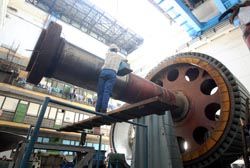Reliable, efficient, safe
Ukraine may play a new role in Europe’s energy balance
The managers of our hydroelectric power stations (HEPS) are convinced that Ukraine’s hydroelectric potential is largely underestimated. The weighty argument of Ukrhidroenerho, the state stock company that incorporates Ukraine’s major HEPS, is the first result of so-called Rehabilitation Project, which is being implemented with the financial support of the World Bank.
The main goals of the project are enhancing reliability, efficiency, and safety of Ukrainian HEPS, alongside with improving their ecological standards. The latter task will be achieved through the minimization of greenhouse emissions, installing environment-friendly hydraulic turbine rotors, and preventing lubricants from leaking into the Dnipro and the Dnister.
“Revamping the equipment will considerably improve the ecological situation in the Dnipro. That is a sure estimate by the World Bank experts,” says Dejan Ostojic, the World Bank lead energy specialist for Ukraine and Moldova.
In addition, according to the Ukrhidroenerho experts, the project will help increase the existing capacities of the HEPS on the Dnipro and Dnister cascades by 300–400 MW and their output, by 500 GW/h. This increase is equal to building a new powerful station. “Such was the output of the entire Kyiv HEPS prior to its revamp. It means that we are virtually building a new hydroelectric power station,” said Semen Potashnyk, director general of Ukrhidroenerho.
According to him, the Dnister SHAPS, which is now at the final stage of construction, will add even more capacity. “It is a storage hydroelectric power station, the biggest one in Europe and, I would even say, in the whole world,” Potashnyk boasted. He assures that the first power pack of this unique facility is expected to be put into operation soon.
Experts note that the project is exceptionally profitable in economic terms. “The project is being implemennted successfully, I may even say, dynamically. We have no doubts that the second stage of the project will be implemented in full scope,” said Potashnyk.
There is plenty of work to be done yet. According to Potashnyk, the second stage includes the reconstruction of the Kyiv, Kakhovka, and Dniprodzerzhynsk HEPS, alongside with Dniprovska-1, the oldest one of them all.
“People believe in our success. We expect to sign the agreement with the World Bank on allocating and additional $60 million for the second stage of the project. The document is ready except for some mere formalities. After signing it, we will start working on Dniprovska HEPS-2. There is an enormous amount of work there,” adds Potashnyk. “It is all about investing into the branch of industry that can yield the highest possible economic effect. The countries that have done their best to develop their hydroelectric power systems are among the richest ones.” This is no wonder, because HEPS produce the cheapest energy, and the current problems with fuel resources do not affect them. Finally, they are environment-friendly. However, why invest big money into increasing electric energy output if the country has a surplus of it? Potashnyk is sure that the surplus will vanish with the end of the crisis. From then on the demand for energy will only grow. In this situation Ukraine could play a new role in Europe’s energy balance, as Ukrhidroenerho experts hint.
The problem of addressing peaks in demand and balancing out the load, according to Potashnyk, exists in both Ukraine and Europe. “So when we put the first power pack of the Dnister SHAES into operation, we will have even more serious export capabilities. We will be able to give the European power grid what it really needs: up to 350 GW (and that from a single pack) at the peak hour,” he said.
The Ukrainian hydroelectric power industry is doing its best not only for the European consumers. “The strategy for developing Ukraine’s energy system until 2030 says that we have to double hydroelectric power capacity bringing it to 11 million kW,” says Potashnyk. “In the 1960s and 1970s about 1,000 small HEPS were built. Nowadays, when the problem of developing alternative energy sources is being addressed, the nearly 70,000 small rivers Ukraine has could play a decisive part with the help of some inexpensive primitive equipment. Austria, Switzerland, and some other countries are examples of this approach. It has to be our primary goal. If we revive our entire system of small HEPS, we will receive about 600,000 kW of additional capacity.”
Martin Raiser, the World Bank country manager for Ukraine, Belarus, and Moldova, says that the project to revamp Ukraine’s HEPS meets the bank’s key strategic priorities since, in the near future, it will be able to boost the country’s economic development. Raiser has been especially impressed by the Dnipro hydropower cascade. “The Dnipro cascade was one of the greatest achievements of the 20th-century engineering. We hope that well-planned investments in its modernization and development will make it possible to retain its strategic significance for the next generations and help Ukraine to produce electric energy in an efficient and ecologically balanced way,” he said.
The HEPS revamp is also good news for our domestic industries because such enterprises as the Kharkiv Electric Machine Factory, Turboatom, Electrovazhmash, Zaporizhhidrostal, Zaporizhia Transformer Factory, and many others are involved in the modernization process. “We receive from abroad only the equipment, which is not manufactured in Ukraine today. In fact, this is the part [of the project] that the World Bank finances,” explained Potashnyk.






